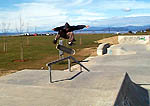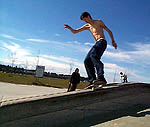|
IN THE BEGINNING.......
Skateboarding, a young sport of which no one truely knows the orgin. Mant stories revolve around the invention of skateboarding. Some beleive that skating began on the surfing beaches of California, USA in the 50's by surfers who put rollerskates on piece of wood.
At first boarding was known as a type of sidewalk surfing which was done when the waves were to small to go surfing.
The orgins of skateboarding are reflected in the design of the earlier skateboards which looked like surfboards. The boards were narrow (4in) and much shorter than boards now and "sidewalk surfers" from the 50's would ride in bare feet and in more sideways stance than we do today. All they would have been able to do is ride up and down the sidewalk and turn by leaning in the direction they wanted to go.
|
 Rail Slide
Rail Slide
|
|
THE FIRST BOOM.....
The first manufactured boards came in 1965. They wereinch-thick wooden boards, with cast-iron trucks and hard rubber wheels. Soon, races down the sidewalk began to vary and competitions between skateboarders were born: free style, slalom, downhill, high jump and long jump.
In the mid-70's skaters started using drainage channels and routes up the slopes around buildings for skateboarding. Skateboarders soon discovered bank skating.
Vert skating then began by using back yard swimming pools. Transitions were to vertical to fast and it would launch them into the air. Skateboarding quickly developed in the US and soon skateparks were built. Pools were built with more rounded sides and then lay-outs for bank and freestylers were built.
|
|
UNTIL the early eighties
parks were the main hang-out for boarders. Competitions and tournaments were organized for them and soon pool and vert skating became the most popular specialist form of boarding.
Vert skating was the most spectacular of the forms. It was incredibly difficult and demanding, which encouraged more changes to be made on the skateboard. The manufacturers built them wider for better stability and changed the old rubber wheels with polyurethane wheels which proved to be faster and had more grip as well.
Barefoot skating was now forgotten except by a few of the old die-hard "sidewalk surfers". The new skaters figured out that gym shoes had more stability and didn't hurt as bad when you wipe-out.
Add your link here
EARLY eighties arrived with a dive in skateboarding popularity.
Skateparks closed the doors, manufacturers stopped manufacturing and worst of all, skateboard magizines switched over to BMXing and rollerskating. But a few hardcore skaters kept going. Those dedicated skaters advanced skateboarding cy creating their own techniques, writing their own magazines, and building some of there own boards and layouts.
This is when half-pipes arrived. Simpler and cheaper than pools, they could be built by the skater himself. Tricks were used in street skating that, before, had only been used by vert skaters, Street ollies, slide'n'rolls, and curb grinds( most of which have different names now) are classic as street skaters moves, all of which were made by vert skaters. Street skating is still probably one of the most popular forms or boarding. Every skater is a street slater because that's where his roots are from. It's just that some skaters forget a few things along the way.
Add your link here
|
 This is one of my favorite images
This is one of my favorite images
|




